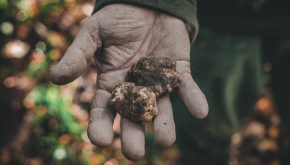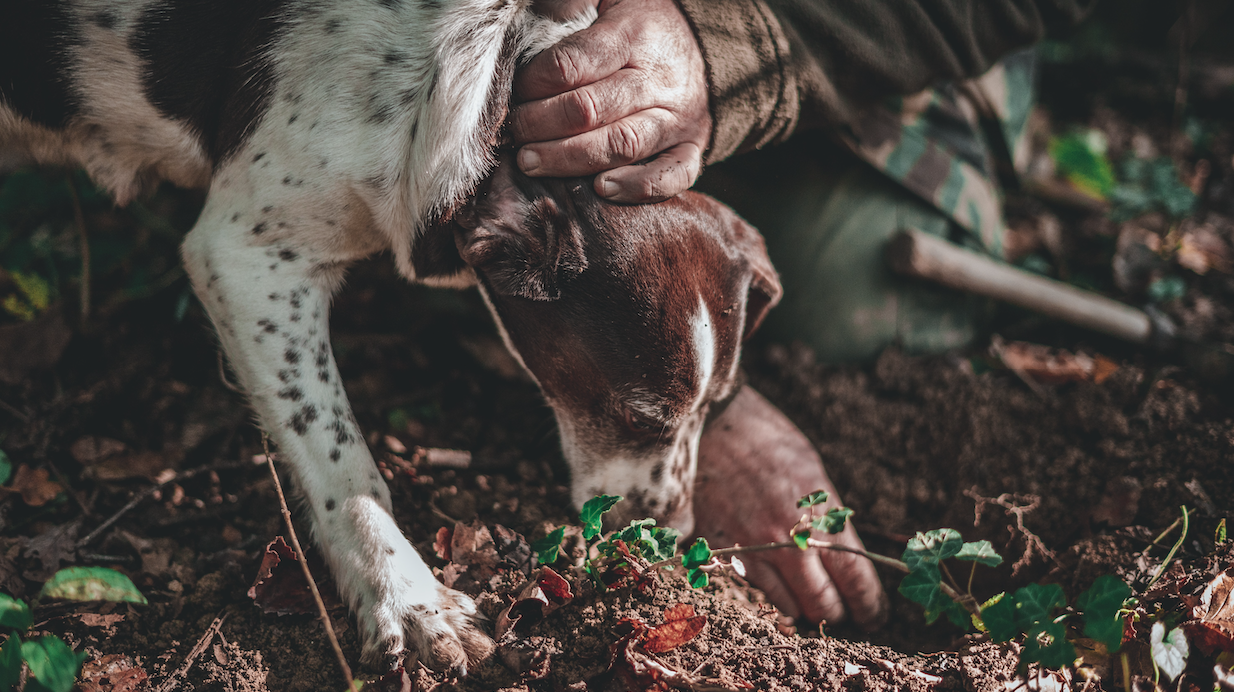
Written by Tiffany Hopkins & Alicia Christiansen
Photos taken by Andrea Cairone
Their alluring aroma and flavor have made truffles one of the most expensive culinary delicacies in the world. The growing conditions in Oregon are perfect for these highly nutritious and highly sought after fungi. A simple shave of one of these truffles takes culinary dishes to a new level, and the demand for them continues to rise.
There are hundreds of native truffle species in Oregon. None of them are poisonous, but only four are considered gourmet edibles by humans. There are two white varieties: the Oregon Winter White Truffle (Tuber oregonense) and the Oregon Spring White Truffle (Tuber gibbosum), both of which are commonly referred to as Oregon White Truffles. The other native culinary truffle species found in Oregon are the Oregon Black Truffle (Leucangium carthusianum) and the Oregon Brown Truffle (Kalapuya brunnea). Each truffle species has its own flavor and aroma profile, and even amongst the same species, subtle nuances in flavor have been attributed to climate, soil, and host species.
Truffles are the seasonal spore-bearing fruiting body of a perennial fungus which forms a symbiotic mycorrhizal relationship with the root systems of specific tree species. These fungi develop slowly underground where they absorb water and mineral nutrients from the soil and pass them along to the tree. In exchange, the tree provides sugar, a product of photosynthesis, to the fungus. Truffles are an important food source for many forest animals, from squirrels to bear. Their aromas evolved to attract animals to eat them, and their spores are distributed in animal droppings.
Habitat:
The conditions most suitable for Oregon White Truffles are young to early-mature Douglas-fir stands that have been planted on former pasture lands. Oregon White Truffles are found from sea level to about 2,000 feet in elevation on the west side of the Cascade Range and in the coastal ranges from northern California to southern British Columbia.
Oregon Black Truffles are predominately found in the western Pacific Northwest in relatively young Douglas-fir forests, frequently in dark loamy soils, often in broad stream drainage bottoms. They are more common where the understory boasts moist moss and fern, and less common in Oregon grape and salal habitats. Although these truffles are found throughout Oregon, they are most prolific in the coast range foothills above the Willamette Valley.
The Oregon Brown Truffle is found in lowland and foothill forests in western Oregon and northern California in similar habitat as the Black Truffle, primarily west of the Cascade Range and the Coast Range foothills above the Willamette Valley. It often fruits in the same places and season as the Oregon Black Truffle.
Identification:
Oregon Winter White Truffle (Tuber oregonense): When immature, the outer layer (peridium) is white to beige, sometimes with yellowish to olive to reddish-brown tints, and the interior (gleba) is firm, white, with traces of marbled texture, and it has little aroma. At full maturity, the exterior is reddish-brown overall, the surface tends to develop fissures, and the interior becomes a smoky brown with prominent white marbling. They range in size from about marble to golf ball and are irregularly round to potato-shaped. Frequently they have little aroma when harvested, even if mature. The odor often develops 1-3 days after harvest, and is described as a complex mixture of garlic, spices, and cheese. It is said that this odor is more intense than its close relative the Oregon Spring White Truffle.
Oregon Spring White Truffle (Tuber gibbosum): The outer layer of this variety of truffle is so thin it is almost translucent and is pale olive to brown-yellow with some brown mottling. The inside is firm and white when immature, and brown with white marbling when mature. It is smooth but has furrows that can produce small hair-like growths (hyphae). The size and shape are similar to the White Winter Truffle. The odor is described as a complex mixture of garlic, spices, and cheese, and like the Winter White is often undetectable at the time of harvest.
Oregon Black Truffle (Leucangium carthusianum): The outer layer of the Oregon Black Truffle, as it’s name hints, is coal-black and warty, but can sometimes have smooth areas. The inside is firm and solid, with grey pockets of spore-bearing tissue separated by a white veining pattern. The aroma most resembles a pineapple (fruity) when young and becomes increasingly pungent as it ages. They range in size from one to five inches across and are often potato-shaped. These are much less common and have a more limited range than Oregon White Truffles.
Oregon Brown Truffle (Kalapuya brunnea): This species is formerly described as Leucangium brunneum. The outer layer is orangish-brown and granular to warty in touch. The inside is firm and solid, mostly white with grey pockets of spores giving a mottled appearance. Like the Black Truffle, they are larger than the White Truffles and have a more limited range. The odor is most commonly described as garlicky.
Harvest:
Each species has its own fruiting season when it is the best time to harvest. Most commonly, this is during the rainy season, although you can potentially harvest truffles almost any month of the year. A good rule of thumb is to look for truffles when above-ground mushrooms, of other species, are in abundance and ready for harvest.
Oregon Winter White: October through February
Oregon Spring White: January through June
Oregon Black: September through February
Oregon Brown: September through February
Truffle dogs are the most effective and efficient way to hunt truffles as they can smell the ripe truffles from over a hundred yards away. Only the truffles that have begun to ripen will emit these aromas so the dogs leave immature truffles undisturbed to continue ripening. Truffles that are harvested before they are mature will not develop the aromas or ripen to the quality expected by chefs. Truffles are only fully fragrant for about a week.
If you do not have a truffle dog to help you sniff out these culinary treats, then you will need to unearth them using a rake that has three to five widely spaces tines (like a garden cultivator). You will use the rake to gently peel back the duff layer on top of the soil, then lightly rake the soil below. You do not need to rake very deep for most truffles – just a few inches will do. If you notice that parts of the earth have been dug up by small forest dwelling animals, that may be a clue that truffles are nearby. Squirrels and mice may unearth a few truffles in an area leaving a small pit behind. Pits will generally be no deeper than a finger in length, and the animals will generally only consume a few truffles in an area, leaving more to mature for a later time. Raking around those pits to about the same depth will sometimes yield a return for your effort. After raking, always return the duff and litter to cover the bare soil. Like mulch in your garden, this protects roots and soil organisms by retaining moisture. Leaving soil bare will ensure the area will no longer be productive. Avoid creating large, continuously raked areas. Instead, keep raking limited to small areas where truffles are most likely to occur. Backfill holes created by raking to ensure adequate cover over any newly exposed tree roots.
Because tree roots are so wide-spread throughout a forest, truffles can be anywhere. Low spots near rotting logs, loose soil, compacted soil, previously disturbed areas like abandoned roads and road banks, and many other locations are all possible habitat for truffles. Generally though, areas with minimal ground vegetation near Douglas-fir trees are a great place to begin your search.
When you successfully find and harvest a truffle collect them in wax, cloth, or paper bag or basket.

Storage:
The proper storing of a harvested truffle is complex. That is one of the reasons for the large price tag that comes along with the fungi (hundreds of dollars per pound). The goal is to keep the truffles alive so they will continue to produce their aromas until they are served. In order to do this, you must ensure they are in an airtight container that is comprised of more air than truffles. The bottom of the container needs to be lined with paper towels to soak up any condensation. They need to be refrigerated and kept dry. One truffle should not touch another truffle. Truffles that were harvested at the right time will continue to ripen after you harvest them and in fact their aroma increases in the days post-harvest. The aromatic compounds in truffles bind with fats, so using a sealed container prevents other foods in your refrigerator from soaking in the strong aroma of the truffles. If all of these steps are taken, you can store truffles for about a week (the exact amount of time depends on species).
Use:
The true truffle flavor lies in its aromatic compounds, which are highly volatile. This means they are never cooked, rather shaved paper-thin over anything fatty and warm (eggs, meat, butter, or cream sauce, etc.). The fat is able to soak up the aroma of the fungus more effectively than other foods. The warmth expresses the oils in a way cool foods cannot. You can also infuse fatty foods (cheese, butter, eggs) with truffle aromas by placing them in the sealed container with truffles, but the foods should never directly contact the truffles (for example, keep cheeses or butter wrapped loosely in wax paper).
If you are a small woodland owner with Douglas-fir trees you may have one or more of these incredible species on your property. The best way to find out if you do is to have a truffle dog pay a visit to your land, or just do some exploratory raking on your own. If that’s not the direction for you, then truffles can be purchased seasonally at specialty grocery stores and through local suppliers. Or you might find a local high-end restaurant serving a truffle dish to enjoy what has been touted as one of the most superior cuisine experiences anyone can have.
For more information, refer to these resources:
Field Guide to North American Truffles
North American Truffling Society
White paper:Tuber gibbosum and Leucangium carthusianum: ecology, harvesting and marketing
Oregon Native Truffles: A primer for commercial production on small forestlands in the Pacific Northwest (By Eric T. Jones, Institute for Culture and Ecology)

